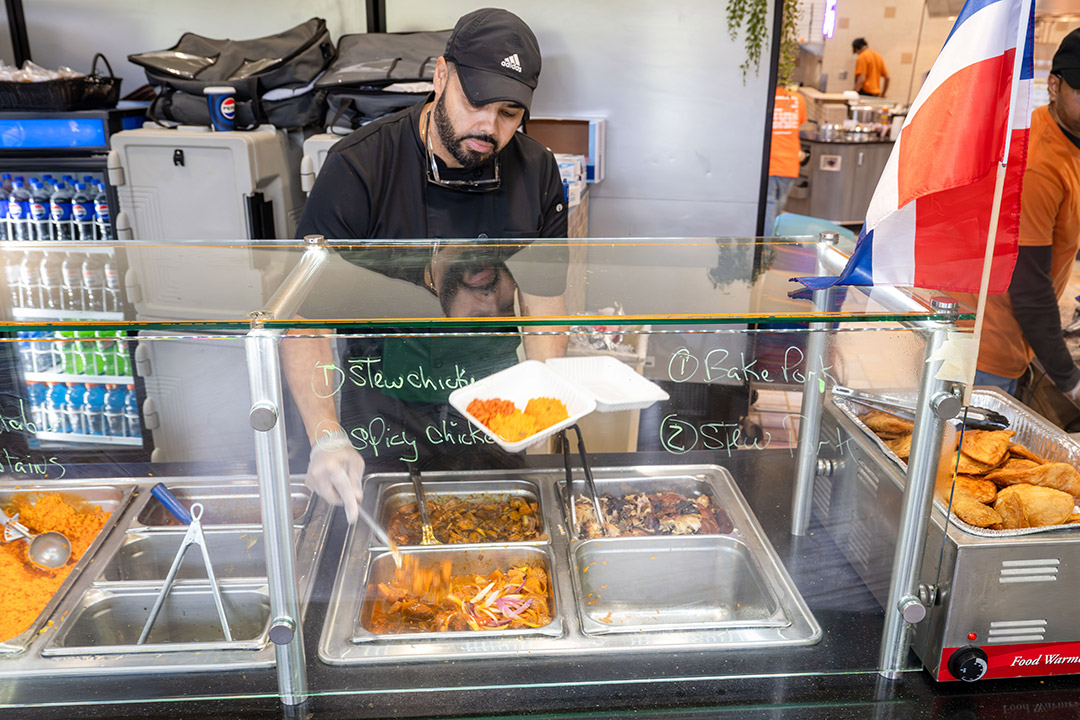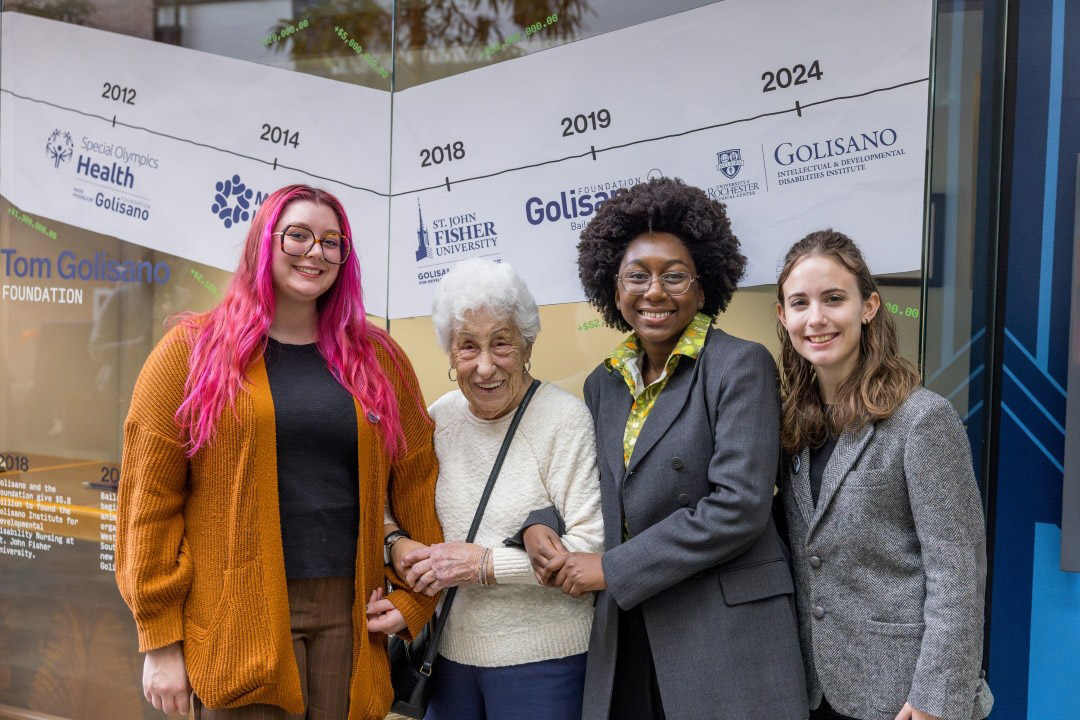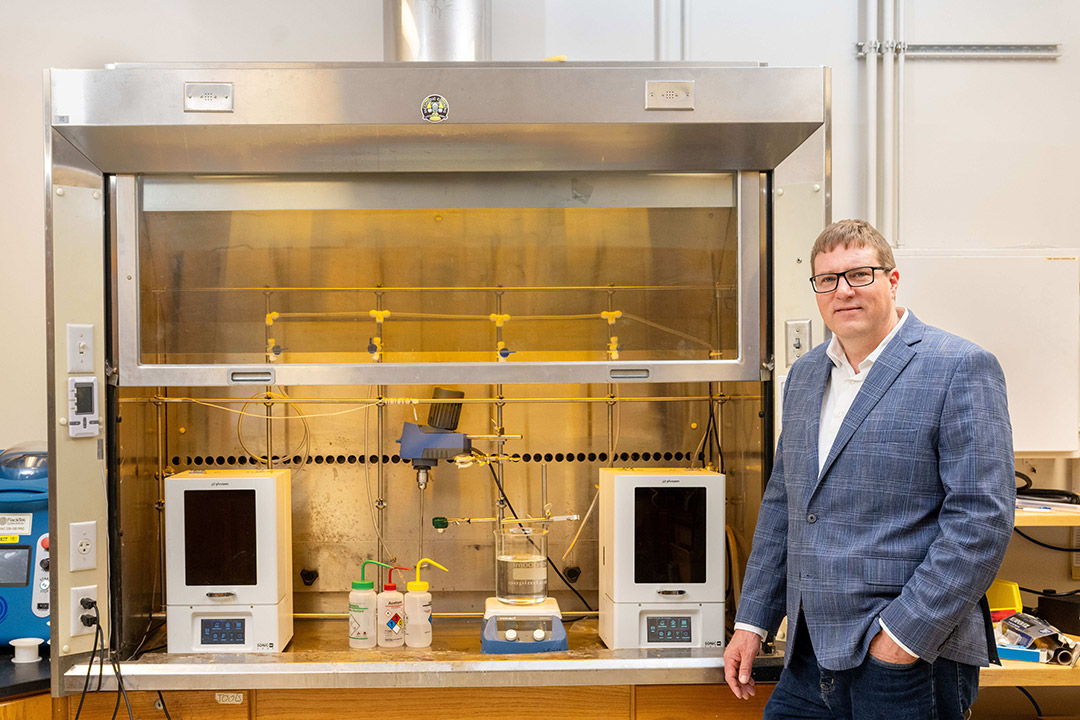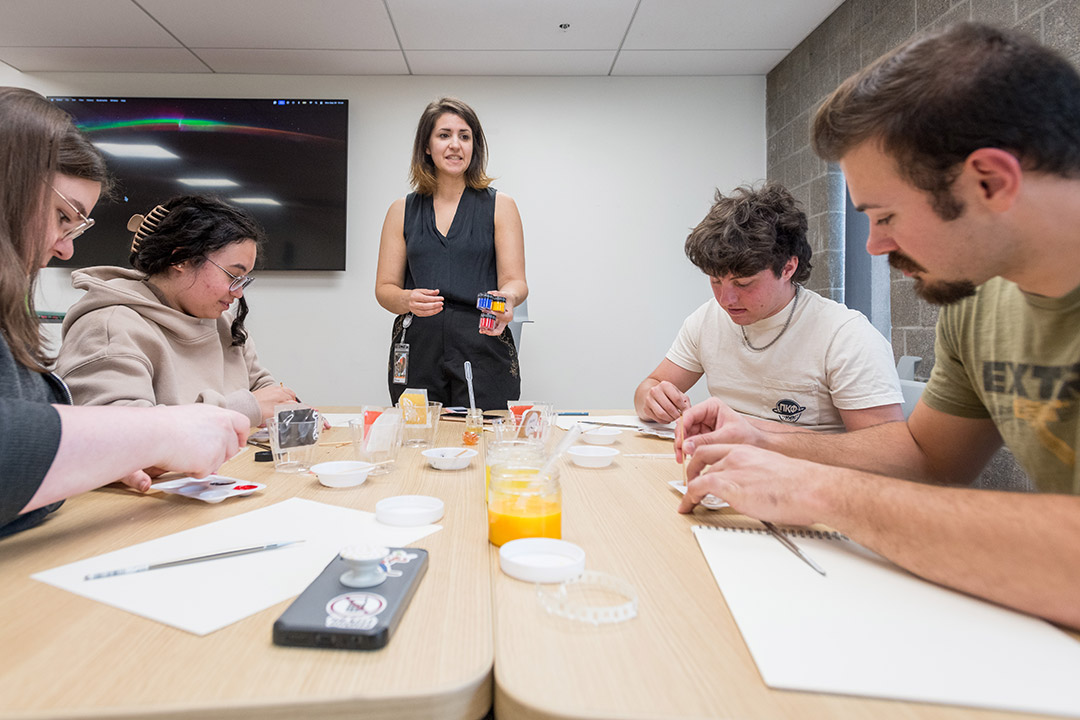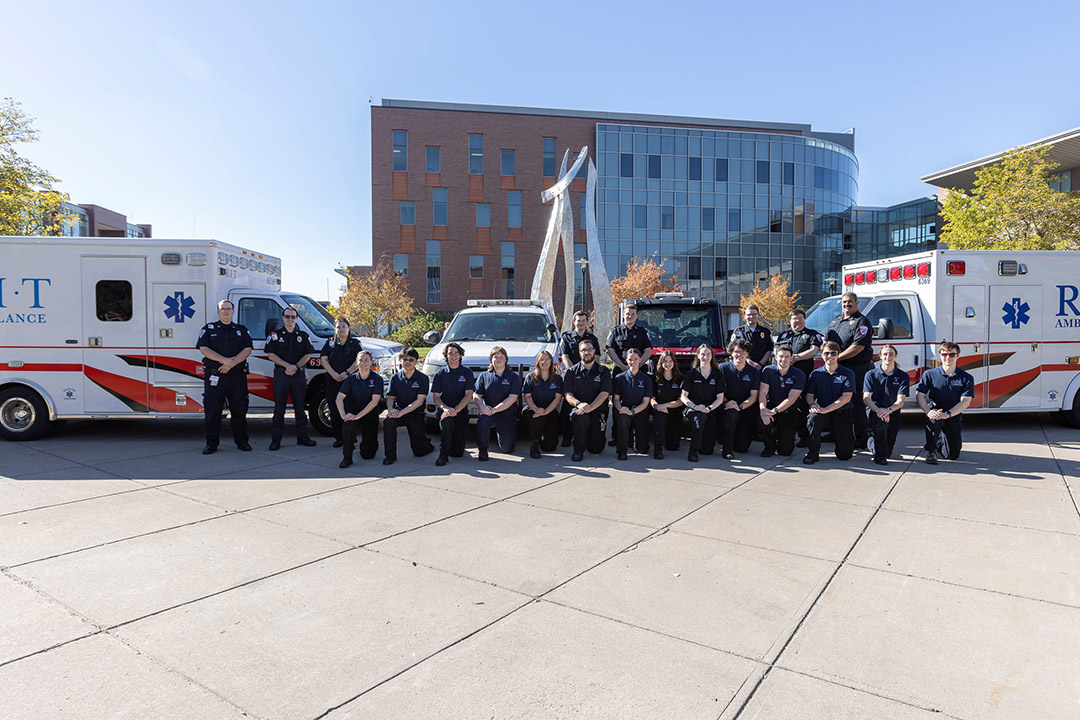RIT introduces esports scholarships
Rochester Institute of Technology is launching its first esports scholarships.
The scholarships recognize students for their competitive video gaming skills and dedication to representing the university at the highest level. Since forming in 2016, RIT Esports has become one of the largest and best collegiate esports programs in the world.
Starting in fall 2025, RIT will offer 20 scholarships for new students—providing $2,000 each year. The university will also offer performance-based scholarships for select current students.
As the esports industry has grown—with millions of viewers and billions of dollars in revenue—more than 200 colleges have formed esports teams. Several have begun offering scholarships.
RIT is not only offering scholarships for competitive student-athletes. RIT scholarships are also available to students with the skills to run esports operations teams. RIT’s seven student-led support teams help run everything from designing the jerseys to running events to broadcasting live-streamed matches.
“We want to attract and support these high-caliber esports students, who are hyper-intelligent and driven to succeed in all aspects of life,” said Chad Weeden, director of esports and cybersecurity range at RIT. “Frankly, it’s also fun to win national championships.”
RIT Esports has brought home 18 national championships, and students have won more than $100,000 in prizes. RIT Esports currently competes in 23 games, including Rocket League, Hearthstone, League of Legends, and Overwatch.
With more than 200 competitive players and around 2,600 community members, RIT Esports is bigger than many college athletics programs.
RIT community supports scholarships
RIT Provost and Senior Vice President for Academic Affairs Prabu David has been a big supporter of RIT Esports. He helped to make the new scholarships happen.
“These esports scholarships recognize our talented student-athletes who use their technical expertise to perform at the highest level,” said David.
David also noted that RIT is consistently ranked as one of the top 10 game design schools, according to international rankings from The Princeton Review.
“Esports at RIT is also a community builder, bringing together students from different majors and backgrounds, including our students who are deaf and hard of hearing,” said David. “We realize that esports is male-dominated and one of the goals of this scholarship opportunity is for RIT to be a leader in showcasing the talents of women in esports.”
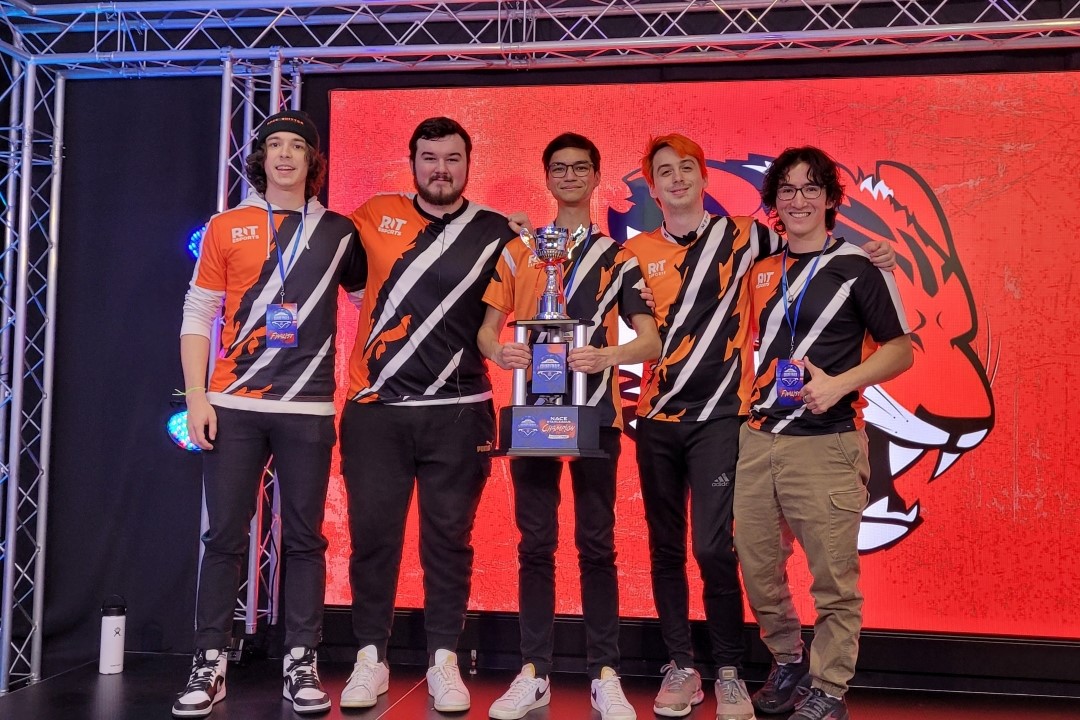
Ben Feldstein, far right, is part of the winning tradition of RIT Esports. Together with RIT’s Counter-Strike 2 team, Feldstein won the 2023 National Association of Collegiate Esports (NACE) Grand Finals
Ben Feldstein, a fourth-year management information systems major and vice president of RIT Esports, worked with the provost to develop the new esports scholarships. Feldstein has also won two national championships as part of RIT’s Counter-Strike 2 team.
“It’s like any other profession or skill, like traditional sports or playing musical instruments,” said Feldstein, who is from Manhattan, N.Y. “There are so many young people who put their blood, sweat, tears, and love into honing their skills to play these titles.”
Feldstein continued. “I think these scholarships are going to help set up students for success after school—whether they make it to the pros or not. We’re proving to everyone that we have great students here and they dream big.”
Latest All News
- Visiting chefs and family recipes offer international flavor to RIT meal optionsWhile pizza, burgers, salads, and subs remain popular choices for hungry college students, there are more options than ever before at RIT dining halls thanks to ethnic dishes brought by visiting chefs and family recipes from staff. “The visiting chef program continues to bring exciting new flavors to campus,” said Herlan Manurung, corporate executive chef and associate director for RIT Dining. “Each visiting chef contributes something new, building on the diverse options our community has access to.” The visiting chefs, nine this semester, rotate among the Ritz, Kitchen at Brick City, and the Café and Market at Crossroads for lunch and dinners during weekdays when classes are in session. “This program also helps our staff learn new culinary techniques and recipes that these restaurants offer,” Manurung said. “Our community comes from different parts of the United States as well as many international countries. By offering a variety of food as well as foods from different cultures, we are hoping to make them feel at home.” Ike Ansari and his cousin Yasin Rao were the first visiting chefs at RIT in 2004, when they brought food from their nearby restaurant, Pakistani House, to campus. The reaction was so good that they eventually closed their restaurant and began P.H. Express to focus on providing more than 1,400 lunches and dinners a week to RIT. Using recipes from his mother and wife, Ansari serves four Halal dishes from Pakistan and India, including his most popular, tandoori chicken with barbecue curry sauce, and vegetable biryani. Each day, he’ll cook up 60 pounds of rice and 120 pounds of chicken, place it in hot boxes and transport it in their van to campus. It’s not uncommon to find 15 to 20 people in line waiting for them to open. “Our food taste is not typical of a restaurant,” Ansari said. Peter Schuck/RIT Sous Chef Kenny McNair provided recipes from his late grandmother’s Puerto Rican dishes for the International Bar at Gracie’s. Employee family recipes are just one way RIT is offering diverse menu items. While Ansari has heard many international students say the food reminds them of home, 90 percent of his customers are not of Pakistani or Indian heritage, he said. Luis Tejeda, who owns D’Mangu restaurant in Rochester, has provided Dominican lunches and dinners five times a week on campus for about 12 years. “Everything’s authentic and seasoned specially,” he said, as he and his cousin, William Del Rio, served hungry students at Crossroads. He posts two small flags from the Dominican Republic, his native country, on the counter when he’s serving. “Where else are you on campus?” asked one student. “Your food is the best. Your pulled pork is terrific.” Chefs specializing in dishes from Nigeria, Korea, and Peru, as well as chefs specializing in sushi and macaroni and cheese (gluten-free or with barbecued chicken and bacon if desired) also partner with RIT, and more may be considered. The diverse menu options don’t always come from off campus. Some recipes are from current employees. Kenny McNair, a sous chef at Gracie’s, stepped up to provide recipes of dishes his late grandmother, who was born in Puerto Rico, used to make. Now her pink beans and rice, plantains, salsa verde pork, tuca en escabeche, and pollo guisado chicken are featured at Gracie’s Latin Bar, which rotates each semester at its international station, along with Indian, Southern, and Caribbean offerings. One student who ordered the beans and rice said she enjoys trying all of the different options as opposed to eating the same thing every day. “It makes me feel good. I’m glad people are enjoying it. It’s all about the enjoyment of eating,” McNair said.
- New exhibit celebrates Golisano’s philanthropyRIT is celebrating entrepreneur and philanthropist B. Thomas Golisano’s legacy with a student-curated exhibit in the Golisano College of Computing and Information Sciences atrium. Members of the Golisano Foundation and Golisano’s sister, Marie Golisano Graham, visited RIT on Oct. 22 for the exhibit opening. The installation, “A Good Deal for Everyone,” focuses on the response to Golisano’s philanthropic contributions through his Golisano Foundation, which was established 40 years ago. “It’s a beautiful exhibit that really fits in with the spirit of giving,” said Golisano Graham. Traci Westcott/RIT Landyn Hatch, from the RIT Archives, spoke about ways that the archives provide impactful source material for students to shape exhibits and share stories. The title of the exhibit is based on a quote from Golisano, “Be brave, be fair, act with integrity and above all, always strive to create a good deal for everyone.” The display includes a historical timeline of Golisano’s giving and recreated thank you cards from people touched by the Golisano Foundation. “When I think about the tangibility of Tom and Marie’s legacy, I always come back to the thank you cards,” said Landyn Hatch, innovation and engagement archivist in the RIT Archives. “Everyone can look at the cards hanging in this case and find something that relates to them.” In 2024, Golisano gave $500 million to various community organizations, including a $10 million gift to RIT. Public gratitude for his generosity is showcased by the hundreds of thank you cards still being archived in the RIT Archives’ B. Thomas Golisano Collection today. Student curators Nicole Feldman and Sophie Abatiell Tommola, both museum studies majors, developed the exhibit concept. Fourth-year graphic design major Ashley Persia created the installations in the Command+g Design Lab, a woman’s design group in the College of Art and Design and a collaborative partner with the RIT Archives. Traci Westcott/RIT A new exhibit from the RIT Archives’ B. Thomas Golisano Collection showcases recreated thank you cards from those impacted by Golisano’s philanthropy. “The waves in front of the thank you cards represent the waves of gratitude that people have for Mr. Golisano’s support,” said Persia. “It was amazing seeing something that I worked on go from an idea on a small screen to becoming a huge exhibit for everyone to enjoy.” Amina Davila-Webster, a fourth-year graphic design major, worked on the historical timeline of Golisano’s giving. She said that the timeline begins at a drawing of a printing calculator—the same machine that Golisano used when creating Paychex that now sits on the desk in the exhibit. The team also produced a timeline for the Wallace Library that documents the numerous student-curated exhibits and projects that grew from the Golisano Collection donated in 2015 by Golisano Graham.
- RIT preservation specialist empowers cultural heritage institutions to adopt sustainable practicesCultivating sustainability in the workplace can look vastly different between industries. While maintaining climate-controlled storage spaces year-round may seem antithetical to the pursuit of environmentally conscious practices, it is a non-negotiable for preserving objects at museums, libraries, and archives. Fortunately, collecting institutions have options for responsibly managing preservation environment needs. Emily Bernal and her colleagues at RIT’s Image Permanence Institute (IPI) are dedicated to helping these institutions adopt more eco-friendly methods for managing these climate control systems. “I think sustainability should be part of the conversation for anything that we do in this field,” said Bernal, IPI’s sustainable preservation specialist. “I feel lucky to act as a bridge between the fields of environmental science, the social sciences, and humanities in this role. What I’m doing is still a little unique, but I’m hoping that we’ll see more positions like mine in the future.” In recognition of IPI’s contributions to the field of sustainable preservation—like the widely-used eClimate Notebook resource—the institute was selected to participate in the new Getty Global Art and Sustainability Fellows program. Fifteen cultural and scientific organizations across six continents were invited to participate in the inaugural year of the program. IPI is one of only two United-States-based institutions included in the program. At IPI, the program will provide funding to support a series of three two-year fellowships over the next six years. Bernal was selected as IPI’s first fellow. This new multi-year global initiative was created by the Getty to support early-career professionals and visual artists “at the forefront of international conversations on climate resiliency,” according to the Getty’s press release. All fifteen participating organizations are known internationally for boosting sustainability in the arts and cultural heritage fields. “Our goal with the Getty Global Fellows program is to create a network of changemakers working to protect collections, buildings, and sites in the face of accelerating climate change,” said Joan Weinstein, director of the Getty Foundation. “IPI’s excellence and international reputation in providing accessible tools and training in cultural preservation makes them an essential and welcome addition to the Getty Global cohort.” Being invited to participate in the program was a “feel good moment” for IPI Executive Director Jennifer Jae Gutierrez. “When we saw the other recipients, it was surprising to see quite a wide breadth of institutions represented. IPI being part of that cohort demonstrates the value of our work now, and the work that we’ve done for decades. It acknowledges that the resources we create have really made a difference,” Gutierrez said. As a sustainable preservation specialist, Bernal uses her background in environmental science to research current and potential best practices for climate control management, specifically in relation to mechanical operations as well as passive environmental control. Her primary role is to serve as a consultant for collecting institutions who are starting or strengthening their sustainable environmental management practices, and she leads technical support for IPI’s web-based environmental analysis software, eClimateNotebook. Support from the Getty fellowship program will enable Bernal to continue this work, with a special focus on creating more resource guides that highlight the multifaceted benefits of sustainable preservation practices and enable more institutions to implement sustainable preservation environmental management. “A big selling point we lean into is that, in many instances, when institutions achieve these sustainability goals, they can have the same preservation outcomes, or even better preservation outcomes, while also lowering energy use and the cost associated to maintaining these environments,” she said. Amplifying some of the field’s current success stories in this area is another major goal of Bernal’s fellowship. “I really want other institutions to see themselves reflected in these publications. I hope they can read the success stories of similar institutions and be inspired to think, ‘even if I can’t follow all of these guidelines, I think I can make some changes now that I’ve seen how they’ve done it elsewhere,’” she said.
- Researchers develop self-healing materials to improve 3D-printing processesSelf-healing materials are being developed by RIT researchers to further improve additive manufacturing, specifically 3D-printed products, to make them stronger and more resilient. Christopher Lewis and members of his research team developed a stimuli-responsive photopolymer solution—liquid resins similar in texture to superglue—that once printed exhibits the ability to self-heal when damaged, and through the lithography process, these liquid resins solidify selectively, layer-by-layer. There is a lot of interest today in materials that can heal, or self-repair, themselves. In 3D printing, the ability to build more reliable parts that have these healing actions can benefit multiple industries and provide cost savings. Companies can rely more confidently on the strength of materials being used for high-precision equipment such as printed electronics, soft robotics, or prosthetics for the aerospace, automotive, and biomedical fields, said Lewis, an associate professor and Russell C. McCarthy Endowed Professor in RIT’s College of Engineering Technology. “When you break a bone, or cut yourself, we take it for granted that there is a self-repairing mechanism that allows for bones or skin to rejuvenate themselves, at least to some extent,” said Lewis. “We also learn that it is not true for synthetic materials or man-made objects. And our work in self-healing materials is a futuristics look at how we can develop systems that mimic those natural material properties.” Peter Schuck/RIT Christopher Lewis, left, discussed the cellular nuances related to the self-healing resins with BS/MS student Kaia Ambrose. Ambrose is part of the team focused on shape memory behavior. Over time, 3D-printed objects can crack, particularly those used in load-bearing applications. This is worsened by the fact that many of the materials used in 3D printing are inherently brittle. Without intervention, the structures can fail. The team discovered that by combining a thermoplastic agent with an ultraviolet-curable resin enables a stronger 3D-printing process, while also creating a blend that reinforces cracked areas. “It makes the material much stronger than it used to be. One of the problems with these soft, elastomeric materials is that they are traditionally weak. And it also engenders another type of property—shape memory behavior, and we are just starting to focus our efforts on better understanding this behavior,” said Lewis. At the forefront of this work for several years, Lewis received funding from the U.S. Department of Defense and partnered with scientists in RIT’s AMPrint Center to test how self-healing materials supplement 3D-print processes. He and co-authors Vincent Mei and Kory Schimmelpfennig, RIT doctoral students, detailed the work in several journals including ACS Applied Polymer Materials, Polymer, and a recent issue of 3D Print Industry. Each highlights the team’s focus on the UV-vat polymerization of this liquid resin system. The challenges, he said, are in regulating the viscosity of the reactive resin, and ensuring all materials are soluble and light sensitive. “The approach we have taken is one where we have a mixture of two different things. We have our photoreactive, thermosetting polymer that once cured becomes a soft rubber. To this, we also add a thermoplastic healing agent. We were able to get light to pass through the system, and we achieved that by utilizing polymerization induced phase separation (PIPS). It is a process where the thermoset and thermoplastic materials separate during curing,” he said. “That is key to this whole thing.” PIPS is a single, segmented function where an optically transparent liquid allows light to pass through. By curing the UV resin, the thermoplastic phase separates. Lewis compared that final phase-separated structure to a lava lamp that changes as it is lit or heated. It is similar with the polymers that transform as they are integrated with the 3D-print as each layer is cured. “Earlier work on thermoplastic polymer blends that are able to be processed using conventional techniques like injection molding or extrusion suggested that it was that phase separation that seemed to be driving the self-healing behavior of those systems. That understanding led us down this path of experimentation with this same healing agent and photo reactive polymer system, and then, a little bit of luck,” said Lewis.
- Ph.D. candidate encourages her class to judge a book by its coverAs a professional paper conservator and color science Ph.D. candidate, Leah Humenuck has studied books from every angle and wavelength. This semester, Humenuck is sharing her love for paper, ink, pigments, and all the material components of a book, in her course, The Secret Lives of Books, a special topics elective offered by the museum studies program in the College of Liberal Arts. She is gaining hands-on experience from the other side of the classroom, working with undergraduate students, sampling an academic career, and adding to her résumé. While the evolution of the book has been a global accomplishment, Humenuck focuses on book development in the Western world and the influence of parchment, which shaped the form, Gutenberg’s game-changing printing press, and the rise of paper. Her class teaches students how to assess a book through its materials and construction. Trends in book development point to available materials and choices often based in practicalities, she said. “There’s more than one way to read a book,” Humenuck said. She alternates her lectures with lab experiences that focus on handling rare books, mixing pigments, learning about book storage, and papermaking. “I think the best way to interact with history is to do the history,” Humenuck added. Christis Shepard, a fourth-year museum studies major from Bayonne, N.J., is enjoying the deep dive into the history of making books. “We’re currently learning about medieval books, the inks medieval scribes and artisans used, and the techniques used in creating parchment,” Shepard said. “It makes me appreciate the ease we have today in making books and that many of these old books managed to survive into the modern day.” Humenuck’s class meets in Wallace Library and frequently visits the Cary Graphic Arts Collection, RIT’s special collection of rare books, and graphic design and printing history. “I wanted to create a class that would intersect with the Cary Collection,” Humenuck said. “I tell my students, ‘While you’re here, use the Cary Collection because it’s phenomenal.’” Humenuck developed the special topics class at the suggestion of Juilee Decker, director of museum studies and co-director of the Cultural Heritage Imaging lab. Decker knew of Humenuck’s interest in an academic career. Liam Myerow A student in the Secret Lives of Books course creates pigments in a medieval method by combining the powdered pigment with a binder in the glass jar. “I enjoy tapping into what students are doing at the graduate level and seeing how they might inform what we’re doing in museum studies,” Decker said. “I thought that Leah’s expertise as a book and paper conservator would provide a materials perspective on a topic that is related to museum studies.” With a focus on libraries, archives, and museums, and a tech-infused approach to liberal arts and sciences, RIT’s museum studies program is one of the few undergraduate degree programs of its kind in the United States, Decker added. Interdisciplinary in nature, the program draws upon expertise from multiple colleges and divisions with a book niche. Steven Galbraith, curator of the Cary Graphic Arts Collection, teaches a course about the history of the book from a curatorial perspective, and faculty at the Image Permanence Institute offer a course about preservation and collections care. “Leah has served as a mentor and an internship supervisor for a number of my students,” Decker said. “I work with her in a research capacity, so I am aware of her excellent scholarship ethics and her keen eye toward mentoring and developing lifelong learning goals for people.” The path to becoming a college instructor is different for every Ph.D. student. The Secret Lives of Books is Humenuck’s first experience writing a syllabus and planning a curriculum for a semester-long class. Decker gave her guidance about classroom parameters and syllabi. She has also sat in on Humenuck’s classes. “It’s common that there’s not a precursor to teaching,” Decker said, reflecting on her doctoral degree at Case Western University. “There isn’t a formal class that says, ‘This is how you become an instructor now that you want to share your knowledge of this topic.’” The opportunity to teach builds upon Humenuck’s experience gained through her many guest lectures and talks, conference presentations, an internship program she created for museum studies, and her semester as a graduate teaching assistant for the Fundamentals of Color Science course. Christie Leone, assistant dean of the RIT Graduate School, said there are a lot of opportunities for graduate students to gain hands-on teaching experience by working as graduate teaching assistants under the supervision of a faculty mentor. Graduate teaching assistants are required to take a training course, GTA Foundations, offered by the Graduate School in collaboration with the Center for Teaching and Learning. The class provides basic background information and introduction to the responsibilities of a graduate teaching assistant at RIT. In addition, some colleges and departments offer their own training specific to their discipline. Humenuck’s class is giving her a multidisciplinary teaching experience. The elective has drawn 17 students from a variety of majors and with different opinions on materials for preserving information. “Being able to answer questions and pull a class together with students having different perspectives is something I really enjoy,” Humenuck said.
- RIT Ambulance expands its fleet with a second rigRochester Institute of Technology, which has had its own emergency medical service for more than 50 years, now has a new, second ambulance available to help students, employees, visitors, even nearby community members in need. Nearly 60 people, about half of them current students, work at RIT Ambulance (RITA) and respond to more than 600 calls a year, ranging from general sickness or traumatic injuries. The ambulance is on standby at sporting events and major gatherings on campus. They also can respond to nearby accidents, fires, or other emergencies off campus if needed. Their calls have been increasing each year since 2021, and there is no charge to the patients. “Sometimes there’s a misconception that we’re just a club,” said Riley Howard, RITA’s vice president and a fourth-year physician assistant major from Allison Park, Pa., who joined RITA three years ago. “Some think because we’re college students, we may be inexperienced. But we receive the same training as all licensed ambulance services.” Some of the RITA members are alumni, and some work or volunteer for outside agencies as paramedics, EMTs and drivers. Dr. Lindsay Phillips, physician/medical director for the Student Health Center, said RITA members inspire her with their commitment to RIT. “They’re responding to injuries and distress across campus nearly every day, even as they juggle responsibilities of academics, work, and social commitments,” she said. “Faculty, staff, students, and visitors all get the same level of attention and professionalism whether it’s a call for chest pain, a sprained ankle playing basketball, or a lab accident.” Phillips said she’s realized over the years the amount of preparation needed to be ready for the variety of responses. Members take rigorous, mentored training as either medics or ambulance drivers, and the duty roster requires thought and pairing of experienced trainers with learners. RITA not only provides valuable medical service, it also provides leadership development opportunities for its volunteers. Large campus events also require coordination and planning with other emergency services. Traci Westcott/RIT New York State Senator Jeremy Cooney helped secure a $272,000 state grant for the new ambulance. “RITA leadership is always planning curriculum, coaching new members through their training, organizing schedules, and creating opportunities for connection with the membership,” Phillips said. “The camaraderie in the corps is amazing.” The new ambulance was made possible with a $272,000 state grant from State Senator Jeremy Cooney that RITA members help craft and submit in 2024. “RIT Ambulance is renowned for their expertise in providing real world medical experience to students and in keeping the entire campus community safe and cared for,” Cooney said. “Our students can only succeed if they feel safe, and that’s exactly why I was proud to deliver state funding for RIT’s second ambulance, a needed step that allows them to continue to serve as a model for what on-campus emergency medical services should look like.” Since 2018, RITA has been recognized by the National Collegiate Emergency Medical Services Foundation as an EMS Ready Campus for its excellence in emergency management and disaster preparedness. The second ambulance, which joins the existing one built in 2013, will enable RITA to respond to service calls even when one ambulance and crew are engaged in an on-campus event. It will also eliminate disruption in case one ambulance needs maintenance or repair. RITA also has a “fly car” that can respond to calls if an additional person is needed, but that vehicle doesn’t transport patients. RITA recruits new members each fall, seeking people willing to spend time to be trained and be available for regular shifts. Normally two people are assigned to shifts, and others will respond if they hear a call and are nearby to help. Visit the RITA website if you would like to possibly join.








